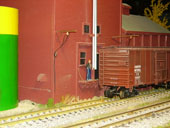“The Co-op” towers 75 feet above the railhead and it can be seen from as far as 15 miles away. Kids still stand at it’s foot, look up, watch the clouds slide over the top and get dizzy until they fall over.
Clearly, the grain industry is central to the economy of Winter Valley and the neighbouring communities of Grande Prairie and Pearson. With one full time employee and one summer helper it’s not what city folk think of as an industrial giant but for about eight months of the year, August through March, this single Co-op elevator is a beehive of activity. Farmers truck their grain in, have it weighed, graded and stored for shipment by rail. The facility also carries a variety of bulk farm supplies.
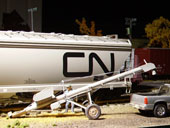 Sometimes farmers deal directly with suppliers and customers. A number of small augers are available on the property. These are used to transfer grain from farm trucks directly into waiting hoppers or from the hoppers into grain trucks without the intervention of the grain elevator. Handy.
Sometimes farmers deal directly with suppliers and customers. A number of small augers are available on the property. These are used to transfer grain from farm trucks directly into waiting hoppers or from the hoppers into grain trucks without the intervention of the grain elevator. Handy.
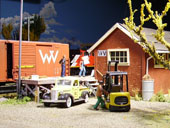 The local warehouse shares a siding with the grain elevator and a scrap metal dealer. Being ‘in the middle’ can cause a problem for management. Things are loaded and unloaded now and “now” can be just about any time of day or night during the harvest. If there seems to be a holdup on the ground the foreman has to get right on top of it.
The local warehouse shares a siding with the grain elevator and a scrap metal dealer. Being ‘in the middle’ can cause a problem for management. Things are loaded and unloaded now and “now” can be just about any time of day or night during the harvest. If there seems to be a holdup on the ground the foreman has to get right on top of it.
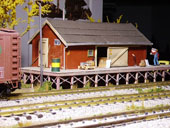 Almost all ‘incoming’ is building supplies or heavy machinery. Furniture and other household appliances are truck traffic now. There is very little ‘out going’ anymore. The scrap dealer seems to have that part of the business all wrapped up.
Almost all ‘incoming’ is building supplies or heavy machinery. Furniture and other household appliances are truck traffic now. There is very little ‘out going’ anymore. The scrap dealer seems to have that part of the business all wrapped up.
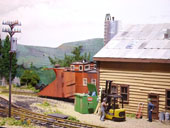 The Winter Valley shops have never been in Winter Valley. The founding fathers simply found the land around Grande Prairie better suited (read cheaper) than property near the lager center. “The shops” consist of a single one-stall engine house, a diesel oil facility, a sanding tower and a small station that’s now used as a warehouse. An over grown spur can still support the odd bad order car, and the snow plow out of season, but the days of maintaining a 2-6-4 are long past.
The Winter Valley shops have never been in Winter Valley. The founding fathers simply found the land around Grande Prairie better suited (read cheaper) than property near the lager center. “The shops” consist of a single one-stall engine house, a diesel oil facility, a sanding tower and a small station that’s now used as a warehouse. An over grown spur can still support the odd bad order car, and the snow plow out of season, but the days of maintaining a 2-6-4 are long past.
Basic diesel maintenance is still completed here buy a small, aging staff of master mechanics but heavy work is farmed out the CN in Edmonton. A new interchange agreement with CN may mean the end to all maintenance work once this crew decides to retire. In the meantime there are still experts around to keep the fires burning in the summer only steam special that’s stored serviceable on a local siding.
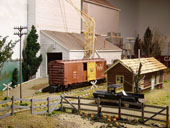 The train doesn’t stop here any more but you can drop by and pick up a pumpkin in time for Halloween. The station supported passengers and freight until it was found easier to collect commuters in Winter Valley. Some repairs were completed on the freight house end but the old building was eventually sold off to a local auto parts dealer. Sad.
The train doesn’t stop here any more but you can drop by and pick up a pumpkin in time for Halloween. The station supported passengers and freight until it was found easier to collect commuters in Winter Valley. Some repairs were completed on the freight house end but the old building was eventually sold off to a local auto parts dealer. Sad.
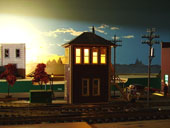 The PSN (Pearsen) tower at Grizzly Jct controls all activity at the CN/WV interchange. This was a busy, and vital, place in the past but in the world of cell phones and GPS it only serves to house the switch mechanisms that still do the actual work. The building itself is minimally maintained and unmanned, opened only on demand, so should the mechanics ever need a major repair or replacement the tower would likely be removed completely.
The PSN (Pearsen) tower at Grizzly Jct controls all activity at the CN/WV interchange. This was a busy, and vital, place in the past but in the world of cell phones and GPS it only serves to house the switch mechanisms that still do the actual work. The building itself is minimally maintained and unmanned, opened only on demand, so should the mechanics ever need a major repair or replacement the tower would likely be removed completely.
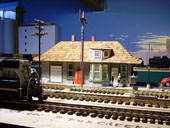 The station at Pearson is in fine condition for a woman ‘of a certain age’ but she pretty much relies on a contractual agreement between the WV and the Pearson Historical Society to maintain her good looks. The PHS looks after the exterior and the WV does upkeep on the inside, as required. Everybody wins. The station serves as the preferred photo shoot location for train watchers and weddings alike. Some great photos result when events conspire to have everything happen at once.
The station at Pearson is in fine condition for a woman ‘of a certain age’ but she pretty much relies on a contractual agreement between the WV and the Pearson Historical Society to maintain her good looks. The PHS looks after the exterior and the WV does upkeep on the inside, as required. Everybody wins. The station serves as the preferred photo shoot location for train watchers and weddings alike. Some great photos result when events conspire to have everything happen at once.
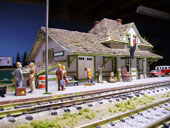 Passenger traffic is still an important part of the life in and around the station at Winter Valley. It slowed down for a while but with the move of people from the near suburbs of the city into a true ‘country’ environment more and more people make the twice a day trip by Dayliner. Large crowds also get together for the once a week football specials that often require extra cars.
Passenger traffic is still an important part of the life in and around the station at Winter Valley. It slowed down for a while but with the move of people from the near suburbs of the city into a true ‘country’ environment more and more people make the twice a day trip by Dayliner. Large crowds also get together for the once a week football specials that often require extra cars.
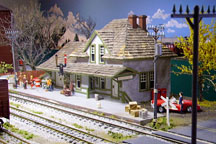 Freight and passengers clutter the platform. There’s enough room in this CNoR 3 rd Class depot to house regular day to day traffic as well as the head offices of the Winter Valley Regional Railway. The staff long ago abandoned the much larger brick and stone structure down town. Perhaps the builders had bigger plans for this railway.
Freight and passengers clutter the platform. There’s enough room in this CNoR 3 rd Class depot to house regular day to day traffic as well as the head offices of the Winter Valley Regional Railway. The staff long ago abandoned the much larger brick and stone structure down town. Perhaps the builders had bigger plans for this railway.
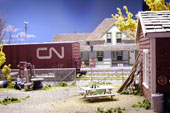 Some conclusions can be drawn by the fact that the junkyard across from the station is one of the ‘busier’ industries in town. Even on a slow day there’s some activity. In this case it’s a few old timers, who sit in the sun, share a few cold ones and remind each other how things were better “in the old days”
Some conclusions can be drawn by the fact that the junkyard across from the station is one of the ‘busier’ industries in town. Even on a slow day there’s some activity. In this case it’s a few old timers, who sit in the sun, share a few cold ones and remind each other how things were better “in the old days”
Life goes on.
